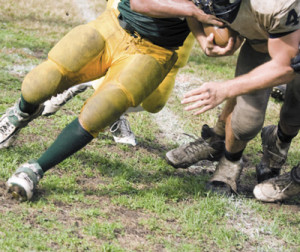
istockphoto.com #7375786
By Jordana Bieze Foster
Some surgeries may predict AC lesions
Research presented this month at the annual meeting of the American Orthopaedic Society for Sports Medicine spelled more bad news for advocates of meniscectomy, potentially linking the embattled procedure to the development of articular cartilage lesions that can progress to osteoarthritis.
Previous investigations have identified meniscectomy as a predictor of osteoarthritis following anterior cruciate ligament reconstruction, including an Australian study published in the March 2010 issue of the American Journal of Sports Medicine. That 56-patient study found that meniscectomy and chondral damage were both strong predictors of tibiofemoral and patellofemoral OA six years after ACL reconstruction.
Now two studies from Washington University in St. Louis, MO, suggest that meniscectomy is associated not just with OA but with the chondral lesions that can precede it. One study found a significantly higher incidence of articular cartilage injury at revision ACL reconstruction in patients with a history of prior partial meniscectomy than in patients who had had no meniscal surgery. And a second study found that meniscectomy was among the knee surgeries that predicted incidence of articular cartilage defects in collegiate football players.
The first study included 725 patients who had undergone revision ACL surgery. Knees with prior partial meniscectomy were significantly more likely to have high-grade articular cartilage lesions than those with no history of meniscal surgery or those with a history of meniscal repair. The chondral lesions were significantly more likely to occur in the same compartment as a prior meniscectomy, but not in the same compartment as a prior meniscal repair.
The second study, which earned the AOSSM’s NCAA Award and will appear in a future issue of the AJSM, involved 594 National Collegiate Athletic Association football players who were assessed at the National Football League’s annual pre-draft combine. More than half (59%) of the players had previously undergone knee surgery; 36% had had a meniscal procedure; and 19% had had an ACL reconstruction. Of the ACL reconstructions, 42% involved concurrent meniscal surgery. And of the meniscal procedures, 91% involved meni- scectomy as opposed to meniscal repair.
Knee symptoms were seen in only 2.4% of the athletes. But magnetic resonance imaging scans revealed full-thickness or partial-thickness articular cartilage defects in 61% of the players. A history of any surgery, and meniscectomy specifically, was significantly associated with the presence of articular cartilage lesions.
As in the revision surgery study, however, the researchers did not find a significant association between chondral lesions and a history of meniscal repair.
“There may be some chondroprotective effect of meniscal repair,” said Robert H. Brophy, MD, assistant professor of sports medicine at Washington University and lead author of both studies, who presented the findings at the AOSSM meeting.
Optimizing range of motion after ACL reconstruction may also offer protection against the risk of osteoarthritis, even in meniscectomy patients, according to research from the Shelbourne Knee Center in Indianapolis.
In 780 patients, K. Donald Shelbourne, MD, and colleagues found that the incidence of radiographic osteoarthritis a mean of 10 years after ACL reconstruction was significantly lower in patients with normal and symmetrical range of motion in both knees than in those with asymmetries.
That trend was even more pronounced in the subset of patients who had undergone meniscectomy than in those with intact menisci. In particular, normal radiographs were seen in 74% of patients with a history of lateral meniscectomy but normal range of motion, compared to just 41% of lateral meniscectomy patients with abnormal knee range of motion.
“With every meniscus category, the addition of abnormal range of motion significantly increased the number of patients with osteoarthritis,” said Shelbourne, who presented his group’s findings at the AOSSM meeting.









